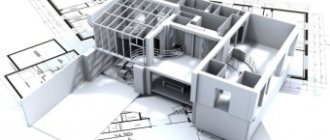Legal aspect
Conducting one or another type of activity on the premises is regulated by relevant legislation. Thus, there are certain requirements for construction, operation, fire safety, sanitary and hygienic standards. The process of repurposing an object involves both external changes and internal re-equipment of the area for a specific type of activity. This task is implemented in accordance with the developed design, technical and inventory documentation. The main problems in determining the legal status of parts of a structure and non-residential areas are architectural diversity and the lack of specific rules for the circulation of this real estate.
Changing the purpose of premises - when and why, how it happens
Each property has its own target value, that is, it is intended for a specific method of operation. It is possible to distinguish different types, groups or subgroups of the intended use of the premises.
1
How is the targeted change of premises carried out?
The intended purpose is not only for the building, structure or structure itself, but also for individual premises in them. This is all due to a variety of legislative, construction, regulatory, operational, engineering, fire and other requirements that apply to all kinds of intended use of a building when carrying out any activity in them.
Repurposing (changing) the intended use of an object involves re-equipping a building for a type of activity that was not initially provided for by its regulatory, technical and inventory documentation. The refurbishment of premises with a change in target profile is carried out based on the administrative document of the executive authority on whose departmental territory the departmental facility is located. To obtain this document, you need to prepare and then agree on a package of design and technical documentation with the authorized services, where the need to change the profile of the structure must be justified without damaging it itself, the buildings that may be adjacent to it, the population, also taking into account the concept of development of urban areas.
Office
The result of the service is: Permission to change the target value of the premises - in Moscow, most often, this is an order of the Prefect or the Head of the Administration, or a decision of a special Interdepartmental Commission that works at the district or city level (depending on the type of object, its primary and subsequent destinations).
It takes from two to eight months to prepare documentation, approvals and ultimately obtain the appropriate permit. This period is influenced by the regulations in force during the period of repurposing for the consideration and preparation of relevant documents, and by the financial viability of the customer of this service.
The most common type of repurposing is the conversion of residential premises to non-residential premises, and the subsequent use of this premises for commercial or non-commercial purposes.
Real estate market
At the end of the twentieth century, there was a fairly rapid development of commercial activity. In this regard, the problem of a shortage of available non-residential space has arisen. At that time, the commercial property market was in its infancy. Subsequently, its development took place in two directions. In particular, the purchase of private residential premises, which were located on the first floors of buildings, was carried out. At the same time, new buildings were erected. The first option was considered quite simple, cheap and fast. New buildings required large investments. The time factor was also important. Nevertheless, practice has shown that it is new buildings that have begun to bring significant profits to the owners. Today there is an intensive development of the commercial real estate market, despite the fact that apartment buildings are being built more often. A fairly large segment of the market today is occupied by non-residential premises for free use. Next, let's find out what these objects are.
What does “vacant premises” mean?
This term is used in the professional speech of realtors. What does “vacant premises” mean? This characteristic indicates the multifunctionality of the object. The intended purpose of the building, as a rule, becomes known already at the design stage. However, for the owner, the option of building a universal structure would be more profitable and expedient in an economic sense. In the future, it can be repurposed to suit tenant requirements. Thus, a free-use premises can become an office or a shopping center. Often such areas are occupied by enterprises in the household or social sectors.
Free-use premises: description, classification
Each property has one purpose or another. This characteristic also determines the method of its operation. If the premises do not correspond to the type of activity of the enterprise, it is unprofitable, or there is a change of tenant or owner, it becomes necessary to change the functional purpose of the area.
Target groups
There are quite a lot of them. Target groups include non-residential and residential facilities, commercial centers, warehouse terminals, shopping malls, educational and medical institutions, public buildings, etc. The intended use can be assigned not only to the structure as a whole, but also to individual areas within it.
Legal aspect
Conducting one or another type of activity on the premises is regulated by relevant legislation. Thus, there are certain requirements for construction, operation, fire safety, sanitary and hygienic standards.
The process of repurposing an object involves both external changes and internal re-equipment of the area for a specific type of activity. This task is implemented in accordance with the developed design, technical and inventory documentation.
The main problems in determining the legal status of parts of a structure and non-residential areas are architectural diversity and the lack of specific rules for the circulation of this real estate.
At the end of the twentieth century, there was a fairly rapid development of commercial activity. In this regard, the problem of a shortage of available non-residential space has arisen. At that time, the commercial property market was in its infancy. Subsequently, its development took place in two directions.
In particular, the purchase of private residential premises, which were located on the first floors of buildings, was carried out. At the same time, new buildings were erected. The first option was considered quite simple, cheap and fast. New buildings required large investments. The time factor was also important.
Nevertheless, practice has shown that it is new buildings that have begun to bring significant profits to the owners. Today there is an intensive development of the commercial real estate market, despite the fact that apartment buildings are being built more often.
A fairly large segment of the market today is occupied by non-residential premises for free use. Next, let's find out what these objects are.
What does “vacant premises” mean?
This term is used in the professional speech of realtors. What does “vacant premises” mean? This characteristic indicates the multifunctionality of the object. The intended purpose of the building, as a rule, becomes known already at the design stage.
However, for the owner, the option of building a universal structure would be more profitable and expedient in an economic sense. In the future, it can be repurposed to suit tenant requirements. Thus, a free-use premises can become an office or a shopping center.
Often such areas are occupied by enterprises in the household or social sectors.
There are a number of features that distinguish such a free-use premises from others. Based on these characteristics, a conditional classification has been formed. So, they distinguish:
- Premises for free use, premium class. It is a new modern building, which is located within walking distance from administrative buildings, transport interchanges or metro stations. The ceiling height of such premises is 4-6 m. They have large windows, modern security and fire alarm systems are installed, and an underground garage and outdoor parking are provided. This kind of free-use premises in Moscow is usually intended for offices of commercial banks and holding companies. Their rent is quite expensive.
- Luxury class free space. Such squares are located in buildings located in the historical part of the city. In this regard, the appearance of the building is maintained in accordance with the style and architecture of nearby objects. In such premises, high-quality and modern renovations have been made, video surveillance and fire alarms have been installed.
- Areas of the “standard” class. They are located in Soviet-era buildings. They have been well renovated. The ceiling height in these rooms is no more than 3.5 m. However, even with signs of modernity, features of the Soviet era are visible in them. This, in particular, is a cramped elevator, low ceiling, non-functional layout, non-functional balconies, and so on. As a rule, small offices are located in buildings of this type. Renting is carried out in separate areas.
- Economy class room. It is located in a residential building and has a separate entrance. As a rule, such space is rented by owners of small shops, enterprises engaged in social activities - hairdressers, small workshops, dry cleaners' reception areas.
Classification
There are a number of features that distinguish such a free-use premises from others. Based on these characteristics, a conditional classification has been formed. So, they distinguish:
- Premises for free use, premium class. It is a new modern building, which is located within walking distance from administrative buildings, transport interchanges or metro stations. The ceiling height of such premises is 4-6 m. They have large windows, modern security and fire alarm systems are installed, and an underground garage and outdoor parking are provided. This kind of free-use premises in Moscow is usually intended for offices of commercial banks and holding companies. Their rent is quite expensive.
- Luxury free space. Such squares are located in buildings located in the historical part of the city. In this regard, the appearance of the building is maintained in accordance with the style and architecture of nearby objects. In such premises, high-quality and modern renovations have been made, video surveillance and fire alarms have been installed.
Premises for free use (PSN)
When starting your own business, in most cases you have to rent a building or a separate small room.
Just the same area, which will be rented out and used by a person, is a free-use premises.
This is a type of commercial real estate, without which a small business would hardly develop.
What is a free-use premises, or it is also called PSN, and for what purposes is it used, we will understand in this article.
What applies to free-use premises?
The following may be classified as free premises:
- non-residential objects;
- Living spaces;
- commercial centers;
- warehouses;
- shopping complexes;
- medical, educational institutions;
- public buildings
- other types.
It is easy to single out a specific group from the PSN, because such a premises can be used for any purpose . Just the same important criterion is that the PSN is used for its intended purpose, for certain purposes.
The target setting is assigned not only to the room as a whole, but also to a separate part of any building (for example, a small room in a building).
PSN classification
PSN in real estate can be classified as follows depending on the purpose of the premises:
- Luxury free space . Such buildings are expensive because... located in the historical parts of the city. The architecture and style here is unusual, the renovation of the premises is done with high quality and in a modern style. Often the premises are already equipped with CCTV cameras, a security system and a fire alarm.
- Premises for free use, premium class . Structures of this type are located next to all places necessary for a person: administrative buildings, bus stops, metro stations, etc. These premises are of a modern type, the ceiling height is 4-6 meters, there are video surveillance systems, security, fire alarms, above-ground and underground parking and others facilities. Renting such buildings is expensive and is largely intended for commercial organizations.
- Premises for free use, class "standard" . These buildings are reminiscent of the Soviet era. The ceiling height is no more than 3.5 meters, the premises themselves are equipped with old things (cramped elevators, inappropriate layout, old renovation). But rent is much cheaper. To a greater extent, such premises are rented individually.
- Economy class free-use premises . Located in residential buildings, there is a separate entrance. Such premises are small in size and intended for small businesses. These could be small shops, enterprises, workshops, hairdressers, etc.
Psn from the point of view of legislative design
Any premises that are rented require legislative support. In accordance with the law, the premises must meet the following requirements:
- for the construction of a building and its operation;
- sanitary and epidemiological standards;
- fire safety.
Due to the fact that in most cases the premises are rented out unequipped, with poor quality repairs, the tenant has to change everything. And for this, design, technical and inventory documentation must be developed.
Rent and sale of vacant premises
In 2020, as well as earlier, the tenant had and still has the opportunity not only to rent a building, but also to buy it. You need to understand each concept:
- , premises are rented for a long term. If the contract provides for a change in the appearance of the premises or its internal components, then the tenant has the right to make repairs and other work.
- Selling a premises is a more serious type of transaction, because... Before buying or selling, you must read all the documentation. It is recommended to do this with an authorized person so that he can explain all the nuances. One of these most important is the following: when purchasing a building, the contract must contain a clause that states that it is possible to convert the premises from residential to non-residential.
Conclusion
Explanation of PSN is a premises for free use, which means any real estate that can be provided to individuals or legal entities, etc.
A free-use premises is a special type of property, which has its own nuances and a variety of purposes for these structures . This form is convenient for a wide range of people.
Rent and sale: some nuances
As you know, any commercial premises must generate income. Stable and constant profit is considered to be the receipt of funds from rent. As a rule, rent is carried out for a long period. When carrying out a transaction for the purchase and sale of premises, it is necessary to carefully study the documentation on the transfer of the area from residential to non-residential. If the building is an old mansion, you should additionally familiarize yourself with the opinions of experts on the possibility of its arrangement. Undoubtedly, among other things, it is necessary to ensure the legal purity of the title papers.
A review of free-use premises, perhaps, should begin with the fact that this concept, as well as the abbreviation used with a similar meaning (PSN), is not a legal term in the strict sense of the word, but rather a colloquial expression. The phrase “vacant space” can often be found in advertisements submitted by both owners and potential tenants.
PSN area
An overview of the market for free-use premises is complicated by their multifunctionality. They cannot be clearly classified as one or another type of space, since in each specific situation the purpose and method of use will be determined directly by the tenant.
It is not beneficial for developers to pre-establish specific characteristics of free-use premises that limit the purpose of a particular space. This would mean that before renting out this or that area, it is necessary to carry out the appropriate redevelopment, finishing work, etc.
However, practical business people are willing to buy or rent vacant premises. This is explained by the fact that in each case, tenants, as a rule, already have a certain set of formulated requirements for the technical characteristics of the PSN. Before using the service of renting vacant premises from the owner, they carefully study the entire package of services (price, payment procedure, area, communications, etc.). It should be noted that most often landlords strive to ensure that the premises they rent out are classified as sales offices or shops, since in these cases the rental rate becomes much higher.
What are the benefits of renting vacant premises?
Let's list some arguments in favor of renting a PSN to start your own business:
- · versatility
(in such buildings or premises you can place a warehouse or office, administrative office or store, and, if desired, you can combine different types of goods and services); - equipment
(as a rule, PSN already have all the communications necessary for work - the entrepreneur only needs to bring the necessary equipment and furniture); - a wide selection of locations
(you can select a PSN in any area that maximally covers the target audience); - · price variety
(every entrepreneur can find a PSN within their means, since prices are determined mainly by geographical location and footage); - integrated approach
(if necessary, you can rent additional space in the same building that is already in use, or in neighboring properties); - benefits
(renting a PSN from the owner is much cheaper than purchasing even the smallest area as property).
If you need to change the type of non-residential real estate, questions arise - where to go, where to start, what to do with title documents, etc.
What is it and why is it needed?
There is no specific definition of a non-residential property, but there are a number of signs that allow an object to be classified as non-residential.
Non-residential premises - real estate, but not necessarily representing separate buildings, but separate parts of buildings clearly delineated by boundaries.
Non-residential properties cannot be used for housing.
A non-residential building may serve as a catering establishment, such as a cafe, restaurant, bar . However, there must be premises used for cooking, storing and cutting food, must comply with sanitary and hygienic standards - be lined with glazed ceramic tiles, have a special floor covering, etc.
Slightly different requirements for medical premises. institutions, and completely different - when non-residential real estate houses a gym, fitness center, kindergarten, office, pharmacy, etc., and not only for san. requirements, but also for fire safety.
Knowing exactly and being able to verify by checking documents that specifically indicate the type of non-residential premises and its purpose is very important when:
The buyer or tenant is looking for non-residential premises for a specific purpose, which will allow them to save money by purchasing or renting the exact area they are looking for, with a suitable purpose and the required finishing.
In the process of preparing paperwork for opening a business, a lot of problems are eliminated if the real estate documents contain records of the intended purpose of the premises that correspond to the area of activity.
When registering for cadastral registration with the State Property Committee (Clause 16, Part 2, Article 7 of Law No. 221-FZ of July 24, 2007), data on the purpose of the premises (residential, non-residential) will also be recorded.
It is very important to prove that the residential building has a non-residential purpose, otherwise the area cannot be used for business.
The rules for maintaining the EDGP, approved by the RF PP dated 02/18/1998 N 219, prescribe an indication of the main purpose of the premises according to the BTI, and clause 67 requires maintaining records of changes.
This means that if you need to change the intended purpose, you should make adjustments in the Unified State Register and State Property Committee database, as well as in your title documents - this is important.
Not only its civil legal status, but also the amount of rent and the purchase and sale price depend on how non-residential premises are designed from the point of view of their intended use.
Now let's move on to the types of purposes of non-residential premises.
Premises for free use - What is it? Description and functions
articles
Let's start with the fact that the legislation does not contain the term “Free Purpose Premises” (PSN). This is more of a real estate term, referring to commercial real estate. PSN means that at the construction stage the premises were not designated for any specific purpose (office, shopping pavilion, pharmacy, warehouse, entertainment center, etc.).
In this article we will examine in detail the features of free-use premises and the extent to which they can be used as hotels.
What does a free-use premises mean?
So, PSN are premises initially designed for various purposes, without any specialization. The purpose of this versatility is to expand the possibilities of subsequent use of the room.
The fact is that if a specific intended purpose is indicated in the design documentation, then it will have to be built in accordance with the requirements for the declared type of premises, in compliance with the relevant fire, sanitary and other standards.
If you specify PSN as the purpose, then the requirements for the premises will be of a general nature, and when renting out such premises or selling them, the owner will not need to do redevelopment so that the premises correspond to the stated intended use. In other words, all the worries about redevelopment and finishing of the premises will not be on the developer, but on the tenant or the new owner if they occupy the premises for specific purposes.
Supporters of PSN believe that the main advantage of this type of real estate is its versatility. For this purpose, PSNs are made with open layouts - relatively speaking, for any future request.
However, let us ask ourselves the question: are PSN really so universal if each specific activity requires compliance with its own norms and rules? In other words, redevelopment and major re-equipment will most likely be inevitable, especially when it comes to transferring the premises to a hotel.
This will require design documentation and project approval from a number of authorities:
- Architectural and planning management;
- Rospotrebnadzor;
- Fire supervision;
- Moscow Heritage Committee, etc.
By purpose:
- shopping: shops, supermarkets, hypermarkets, shopping centers, pavilions, pharmacies, car dealerships, etc.;
- warehouse: warehouses, warehouses, etc.;
- “catering”: restaurants, cafes, bars, etc.
; - service industries: consumer service points, beauty salons, exchange offices, hairdressers, fitness centers, Internet cafes, etc.
; - hotel and recreational purposes: hotels, sanatoriums, holiday homes, boarding houses, etc.).
By functional purpose
(depending on the technical characteristics and design features that allow the room to be used as an independent object)
- basic;
- auxiliary;
- serving;
- communication;
- technical.
So, if the premises are registered, for example, with the purpose of “children’s center”, then in order to convert it into premises for another purpose (for example, “shop”) it will be necessary to bring it into compliance with the standards for a new type of real estate, as well as making changes to the documentation .
In addition, technical difficulties may arise when changing the functional purpose of the room. For example, a kitchen (functional purpose) in a cafe (purpose) must comply with all legal requirements: be equipped with appropriate ventilation, finished with suitable tiles, etc.
PSN, according to the developers, is suitable for any type of real estate. True, it will be possible to use it effectively only after it has been converted by the tenant or the new owner for specific purposes.
Psn and hotels
Despite the fact that the real estate market offers quite a lot of PSN, including for hotels, let's see how the acquisition of such premises will be justified without a radical redevelopment.
For example, let's look at hotel requirements. Let’s take such a “trifle” as the minimum width of the corridor. In particular, it should be sufficient so that, if necessary, a guest and a housekeeping trolley can comfortably separate in the corridor.
But there are also such things as dividing the flow of different guests (guests and those who came to the event), guests and staff (separate entrance, elevators), arrangement “under one roof” of premises for various purposes: rooms, restaurant, fitness center, etc.
We wrote in detail about the features of hotel design, as well as the current norms and regulations in the “hotel” industry in the articles “Hotel plans: layout, drawings of standard projects” and “Nuances of hotel construction: approval of design documentation”
Speaking about real estate for hotels, we can draw an analogy with banks: institutions conducting transactions with valuables must meet many criteria: the location of the premises relative to each other and their purpose, the material for making windows and doors, etc.
As a rule, PSN do not meet such requirements, and banks prefer to purchase premises specially built for these purposes.
PSN for mini-hotels and hostels
Until recently, mini-hotels and hostels still had a legislative “loophole” for accommodation in an apartment building. In particular, part 2. Art. 23 of the Law of March 30, 1999
No. 52-FZ “On the sanitary and epidemiological welfare of the population” states that “...providing non-residential premises to citizens for permanent or temporary residence is not allowed.” Consequently, the hoteliers concluded that at least a small accommodation facility could be placed in a residential area.
However, on October 1, 2020, the law “On Amendments to Article 17 of the Housing Code of the Russian Federation” comes into force, prohibiting the organization of hotels and the provision of hotel services in an apartment building.
Legal consequences of the new law (“either-or”):
- Closure of a hotel or hostel located in a residential area;
- Continuation of activity if the premises acquire non-residential status. This is possible if the apartment is located on the ground floor of an apartment building or above the first floor, but the premises located directly below the apartment being converted into non-residential premises are not residential.
It seems that against the backdrop of these legislative changes, attention to premises that initially have the status of non-residential (and these include premises for free use) will increase.
It is possible that PSNs on the ground floor of apartment buildings or business centers will be in demand for hotels.
Let's look, for example, at what the real estate market (including) now offers for hotels.
- “Free appointment, Moscow, Southern Administrative District, Nagatino-Sadovniki district, Sky Fort residential complex; from 150 to 542 m², from 300,000 to 1,084,000 ₽/month. The premises are located on the first and second floors with a separate entrance from the entrance street. There are fire safety installations, high-power hoods, a hall layout, and panoramic glazing. Ideal for a cafe/restaurant, hookah bar, fitness, bank, also possible for a store, beauty salon, pastry shop, medical center, pharmacy, flowers, etc.”
As you can see, in the detailed description there is no mention of a hotel, despite the fact that in the brief description of the property, hotels are present “on an equal basis” among other types of real estate.
- “Vacant appointment (B+), 377 m² in business, Moscow, Central Administrative District, Basmanny district, st. Solyanka, 1/2С1, 377 m², 1,439,009 ₽/month. The room is corner, located on the courtyard side of the house and is clearly visible from 2 streets, Zabelina and Solyanka. The area is 377 m2 on three levels. The area of the first floor is 141 m2, the mezzanine of the first floor is 84 m2 and the basement is 152 m2. The ceiling height in the basement is 5 meters. Up to 200 kW of electrical power is allocated to the room; there is space for installing ventilation with output to the roof of the building. The close proximity of the Kitay-Gorod metro station and Zaryadye Park ensures high, intense pedestrian traffic and future restaurant customers...”
The detailed description in this advertisement is also not intended for the hotel.
By the way, an analysis of advertisements offering PSN on the ground floor showed that premises are much more often offered for hostels than for hotels. Moreover, even in those advertisements that indicate hotels as one of the possible options, the detailed description indicates “non-hotel” purposes for using the premises as the highest priority (restaurant, office, etc.).
Purpose of non-residential premises
The intended purpose of non-residential premises is the type of area, which is recorded in documents and determines the possibilities of use and can serve as a limitation.
Initially, when a building is being built, the purpose is indicated on the floor plans in accordance with the explication, which, upon commissioning, receives its intended purpose, which appears in the documents (based on the project).
Both in a residential building non-residential premises can be allocated, and in individual non-residential buildings, these areas, in accordance with the design documentation, can be named:
- pharmacy;
- store;
- office;
- dental office;
- library;
- entertainment center, etc.
But in each such case, the non-residential object immediately receives a purpose recorded in the documentation.
Changing the purpose of non-residential premises
Objects that are suitable for a cafe, a store, an office space and others are classified as non-residential. They are not limited in use, like residential ones, i.e. more multifunctional.
It is important to know that the use of a certain type of room has its own limitations, in other words, limits. The copyright holder himself can personally change the purpose of his non-residential premises, i.e. instead of a store, organize an office or something else, the tenant must seek consent from the copyright holder. To change the intended purpose of a non-residential premises, it is necessary to first find out for what purposes the premises were used, its purpose, in order to initially determine the circle of organizations with which it will be necessary to further agree on an “approval act”, then contact the department of architecture and urban planning of the city administration with a statement indicating what the non-residential premises will be used for, with the necessary documents of ownership of the said earlier premises, and also attach to the documents a draft of the redeveloped desired object prepared in the prescribed form, in the event that reconstruction or redevelopment is necessary to change the intended purpose, the specified application is considered in within 45 days, after which an “approval act” is issued, which must be signed by all parties, primarily the administration, sanitary and epidemiological station, utility services and other necessary organizations, depending on the further type of activity of the property. Next, it is necessary to make changes to the unified state register of rights to real estate, namely, contact the BTI, call a technician to inspect the premises, after which changes will be made to the technical and cadastral documents, the owner, who is also the copyright holder of the property, has the right to apply. another person on the basis of a notarized power of attorney (Clause 1, Article 16 of Law No. 122-FZ). Based on the documents submitted to the Office of the Federal Registration Service, all relevant amendments will be made to the register.
Sincerely, Nikitin Oleg.
Non-residential premises for free use
There is a trick to expand the area of use of real estate by calling it non-residential premises for free use. What is this - non-residential premises for free use?
These are universal objects that can be used by tenants for various activity profiles, excluding special.
Free-use premises (hereinafter referred to as PSN) can have different areas, which, when placing offices or retail outlets, can be easily divided by installing prefabricated partitions and organizing the required number of compartments.
With PSN there are fewer problems when organizing your own business, they are easier to rent and sell, and the cost is much higher than with a specific connection to the purpose of operation.
What does a free-use premises mean?
August 13, 2010 — 16:46
Vacant premises (PSN) are apparently the most controversial segment of the commercial real estate market. On the one hand, this format is universal, since it allows the use of space for different types of activities, on the other hand, it is the most vulnerable precisely because of the lack of a concept for the use of premises.
Free format
With such segments of commercial real estate as shopping and business centers, warehouses, everything is clear: they can be counted, classified, and their market share can be determined. It’s more difficult with PSN. This format is practically impossible to systematize, since it has no class or other characteristics.
At the same time, it cannot be ignored: the segment has its own niche, supply and demand.
Denis Kolokolnikov, CEO of the consulting company RRG, judges the share of vacant premises according to supply: “Before the crisis, PSN in the structure of supply in the commercial real estate purchase and sale market was 13–14%.
In the last two years - 17–18%.” Previously, many owners of square meters tried to position their premises from the very beginning.
During the crisis, the expert explains, it has become much more difficult to sell or rent out space, therefore, in order to get an additional number of potential buyers, owners are now declaring a wider scope of use for their property. It is also not easy to say clearly what PSN are. “This is no longer street-retail, which includes premises of up to 500 square meters. m, located on the first line of buildings along busy highways and near metro stations. However, in terms of their functionality, PSNs can border and sometimes overlap with one or another segment,” explains Yuriy Taranenko, director.
These can be built-in and attached premises in residential buildings or separate objects, for example, administrative buildings in industrial zones. Meanwhile, there is one difference that makes the PSN segment special - open layouts, thanks to which such areas are suitable for various types of activities.
Chance for illiquid assets
The first floors of residential buildings have never been prestigious. However, after privatization was allowed in the country, and business began to develop rapidly, having an apartment on the first floor in a building on a busy street turned out to be very profitable.
Businessmen bought such premises for good money, after which the former owners had the opportunity to move to a more spacious apartment with better conditions. Moreover, all the problems, including the search for alternative housing, were taken on by the entrepreneur.
He transferred the vacated apartment to the status of non-residential premises. Interest in the problem of converting residential premises into non-residential premises does not wane even now. True, the peak of such transactions occurred in 2005–2006. But at the moment, after a slight crisis lull, according to Yu.
Taranenko, there is an increase in the number of such requests. There are reasons for this. “Today, non-residential premises can be 50–100% more expensive than an apartment of similar size located in the same building.
The transfer of objects from residential to non-residential gives a chance to an illiquid apartment located on the ground floor, overlooking the roadway,” explains the expert.
Practice shows that translation costs can amount to 30–40 thousand dollars, and the entire process can take from two to three months to a year and a half.
Whether the game is worth the candle depends on the apartment and its location. For example, housing on the ground floor with windows facing the street is perfect for a store. In this case, the translation, according to D.
Kolokolnikov, it’s worth the effort: in a good location, the rental rate for a retail space can be five to seven times higher than the rent for an apartment. The expert also cites the example of mansions and historical buildings, which, according to him, are very popular in terms of conversion to non-residential use. He calls it a non-renewable resource that will always be liquid and in demand.
Vulnerable position
PSNs are found in all areas of Moscow, as well as outside the Moscow Ring Road. They are all of completely different quality. Free-standing buildings that can be classified in this segment are often located in new areas, for example in Mitino, Zhulebino, Solntsevo. In the center of the capital, squares are the most expensive and in demand.
“The rental rates depend on location, area and traffic. Traditionally, the west of Moscow is more popular, the east less so. In general, rental rates can range from $300 to $700/sq.m. m, in some cases up to 1 thousand dollars/sq. m,” Yu. Taranenko cites the data. The rental rate also depends on the purpose of the space.
Thus, according to Dmitry Volkov, head of the consulting and assessment department at Praedium Oncor International, the cost is higher for PSN, which can be used as a trading one, and accordingly, the demand for them is higher. In the case of an acceptable location, renting out such premises for offices does not allow obtaining a comparable level of income.
Demand for this segment is generated by various market players. Among them are service sector enterprises, companies focused on the sale of specialized goods (devices, equipment, goods for repair and construction), which require a showroom, etc. These are the main tenants of such premises.
Pedestrian traffic is not decisive for such a business, since attracting customers comes through advertising. PSN areas are also put up for sale. The price is determined by the same factors as for rent. According to Yu. Taranenko, for detached buildings with an area of 1–3 thousand square meters.
m, you can focus on the cost of selling premises in small shopping centers, which ranges from 2.5 to 3.5 thousand dollars / sq. m. m, for the first floors of residential buildings it is higher - from 3.5 to 5.5 thousand dollars / sq. m. m. During the crisis, the segment turned out to be the most vulnerable, which many explain precisely by the lack of a clear concept for the use of these premises. According to D.
How to change the purpose of the territory?
Many citizens ask the question: “How to change the purpose of non-residential premises?” Let’s figure it out.
If the new direction of activity does not entail drastic interventions in the layout and design of the premises, then changing the intended purpose of a non-residential property will not be particularly expensive in terms of time or money.
On his own initiative, the tenant is not given the right to change the intended purpose of the property, but only with the consent of the owner or on his instructions, executed by a notary.
For any type of activity, you will need to obtain approval in the form of a conclusion from the State Fire Inspectorate at the level of the district fire inspection department.
Next, it is important to obtain the opinion of Rospotrebnadzor, since this is the body in charge of the dignity. epid. permits, without paper from this body it is impossible to start operating a catering establishment, store, etc. You need to order plans for the rooms below and above from the BTI.
Even if the owner himself is completely sure that the premises are suitable and meet all the requirements of the Resolution of Ch. state rank doctor of the Russian Federation dated 09/07/2001 N 23, then his confidence means nothing without a document from Rospotrebnadzor specialists.
Then you should prepare:
- title papers for the property;
- registration certificate;
- explication, floor plans;
- certificate on the technical condition of the building structures (from the BTI);
- a recent document on inventory value (from the BTI);
- a paper from housing and communal services confirming that there are no debts to pay for utilities.
When starting activities in a new field, it is important not to forget to notify Rospotrebnadzor about this (Article 8 of Federal Law No. 294).







